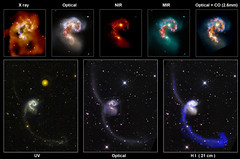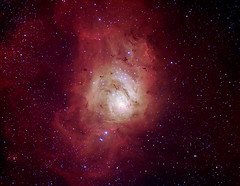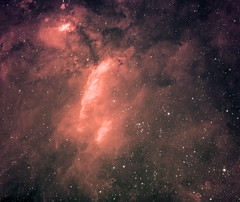Last Tuesday 29th April the Earth, the Moon, and the Sun aligned to produce one of the most spectacular astronomical phenomena we can see: a solar eclipse. The 29th April solar eclipse was actually not a total eclipse (i.e., the disc of the Moon didn’t cover all the disc of the Sun) but an Annular eclipse. The annular phase could be only visible in Antarctica, but a partial solar eclipse was seen throughout Australia in the late afternoon. More information about this solar eclipse can be found in the NASA Eclipse Website managed by the astrophysicist Fred Espenak.
The Sun would be eclipsed by the Moon during the sunset, it was then a perfect opportunity to get some nice photos of the eclipsed Sun with some famous buildings such the Sydney Opera House or Sydney Harbour Bridge. With this excuse, but also with the idea of showing the wonders of Nature to the public, a group of astrophysicists working at Australian Astronomical Observatory (AAO) decided use this solar eclipse to organize our first “Guerrilla Astronomy” event (*). The aim of these activities is to set up amateur telescopes in a public area (a park or a shopping center) and explain to the public who is around what Astronomy is, what astronomers do, and what the “Australian Astronomical Observatory” is. More of these events are coming in the future, but this was our first “test” to see how we can organize and manage the activity.
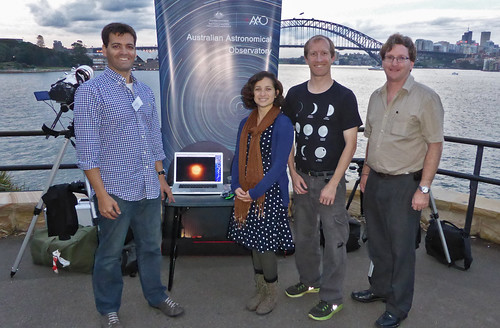
Participants to the first AAO “Guerrilla Astronomy” Event. From right to left, Stuart Ryder (AAO/AusGO), Kyler Kuehn (AAO), Paola Oliva-Altamiro (Swinburne/AAO) and Ángel R. López-Sánchez (AAO/MQ). The laptop shows the only good image we could get of the eclipse using my telescope. Mrs Macquarie Chair, Sydney Botanic Gardens / Domain, 29 Apr 2014.
Photo Credit: Stuart Ryder (AAO/AusGO).
Given the time and position of the Sun during the eclipse, we decided that a really nice spot to prepare our telescopes would be Mrs Macquarie Chair point, in the Domain, Sydney Botanic Gardens. From there a very dramatic view of the Sydney Opera House and the Sydney Harbour Bridge is seen. We first requested permission to do this to the authorities of the Domain, who were really nice and even allowed us to park by free. Actually, they also came along to see the eclipse and they liked our idea of organizing more “Guerrilla Astronomy” events there in the nearby future.
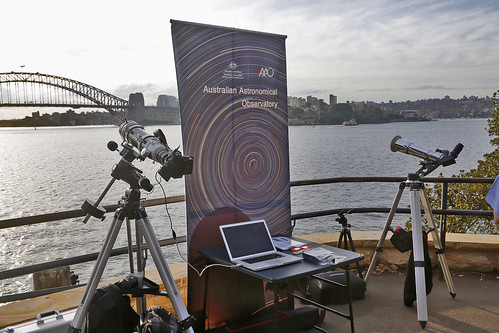
All set up for eclipse: two telescopes (Stuart’s at the right, mine at the left), the AAO banner, my laptop and camera to take photos through the telescope, the eclipse glasses and extra information about the eclipse to give to the visitors. Mrs Macquarie Chair, Sydney Botanic Gardens / Domain, 29 Apr 2014.
Photo Credit: Ángel R. López-Sánchez (AAO/MQ).
It was four of us, Stuart Ryder (AAO/AusGO), Kyler Kuehn (AAO), Paola Oliva-Altamiro (Swinburne/AAO) and myself, who participated in this first “Guerrilla Astronomy” event. Just to have everything ready on time, we were setting up telescopes, AAO banner and laptop around an hour before the beginning of the eclipse. The weather seemed very clear in the morning, but in the afternoon, as we feared, some clouds started to arrive from the west. We already knew this would be a killer… but we had to try!

Kyler and visitor using the solar glasses. First AAO “Guerrilla Astronomy” Event: partial solar eclipse on 29 April 2014 over Sydney Harbour. Mrs Macquarie Chair, Sydney Botanic Gardens / Domain.
Photo Credit: Paola Oliva-Altamiro (Swinburne/AAO).

Little girl using the eclipse glasses. First AAO “Guerrilla Astronomy” Event: partial solar eclipse on 29 April 2014 over Sydney Harbour. Mrs Macquarie Chair, Sydney Botanic Gardens / Domain.
Photo Credit: Paola Oliva-Altamiro (Swinburne/AAO).
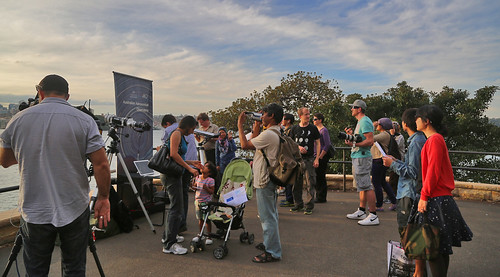
Visitors, but clouds please go away! First AAO “Guerrilla Astronomy” Event: partial solar eclipse on 29 April 2014 over Sydney Harbour. Mrs Macquarie Chair, Sydney Botanic Gardens / Domain.
Photo Credit: Paola Oliva-Altamiro (Swinburne/AAO).
We actually were a bit lucky at the beginning, and hence we could see the Sun within thin clouds and follow the eclipse for 10 minutes. I even could take a nice image:

Partial Solar Eclipse from Sydney on 29 Apr 2014. Telescope Skywatcher Black Diamond D = 80 mm, f = 600 mm + CANON EOS 600D at primary focus + Solar filter. Just 1 frame at ISO 400, 1/8 s, colour processing using Photoshop. 29 April 2014 @ 16:20 AEST ( 06:20 UT ). First AAO “Guerrilla Astronomy” Event: partial solar eclipse on 29 April 2014 over Sydney Harbour. Mrs Macquarie Chair, Sydney Botanic Gardens / Domain.
Photo Credit: Ángel R. López-Sánchez (AAO/MQ).
After that, thick clouds arrived and this happened:
5-seconds timelapse video obtained combining 25 images taken with Telescope Skywatcher Black Diamond D = 80 mm, f = 600 mm + CANON EOS 600D at primary focus + Solar filter, at ISO 400, 1/8 s, showing how the clouds completly cover the eclipsed sun. 29 April 2014 @ 16:20 AEST ( 06:20 UT ). The direct link to the YouTube video is here.
Credit: Ángel R. López-Sánchez (AAO/MQ).
Once the Sun was completely covered by thick clouds we just waited and hoped for a little gap, but unfortunately this never happened and we didn’t see the Sun again that day.

Stuart and his telescope, Kyler and visitors, all hoping the clouds go away. First AAO “Guerrilla Astronomy” Event: partial solar eclipse on 29 April 2014 over Sydney Harbour. Mrs Macquarie Chair, Sydney Botanic Gardens / Domain.
Photo Credit: Paola Oliva-Altamiro (Swinburne/AAO).
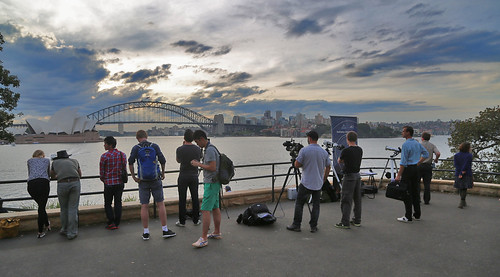
The eclipsed sun is setting behind those think clouds. First AAO “Guerrilla Astronomy” Event: partial solar eclipse on 29 April 2014 over Sydney Harbour. Mrs Macquarie Chair, Sydney Botanic Gardens / Domain.
Photo Credit: Ángel R. López-Sánchez (AAO/MQ).
Well, it would have been really nice to see the eclipsed sun setting over the Sydney Harbour Bridge and sinking later close to the Sydney Opera House, I’m sure the images and time-lapse video would have been quite spectacular, but the best I got was this image:
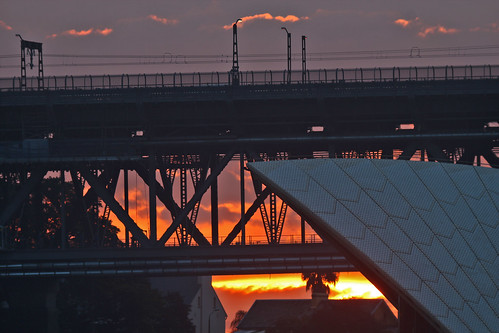
An eclipsed sun should be setting around there… Imagen taken using a Telescope Skywatcher Black Diamond D = 80 mm, f = 600 mm + CANON EOS 600D at primary focus. First AAO “Guerrilla Astronomy” Event: partial solar eclipse on 29 April 2014 over Sydney Harbour. Mrs Macquarie Chair, Sydney Botanic Gardens / Domain.
Photo Credit: Ángel R. López-Sánchez (AAO/MQ).
In any case, all four AAO participants were very happy about how the event was and, as I said, we are expecting to repeat these “Guerrilla Astronomy” activities in the nearby future.
Next solar eclipse to touch Australia will be on 9 March 2016, but it will also be a partial eclipse only visible on the northern and western parts of the continent. The next total eclipse to be seen from Australia will happen on 20 April 2023 and it will just touch the coast of Western Australia. We have to wait until 22 July 2028 to see a total solar eclipse in Sydney. Actually, Sydney is almost exactly in the center of the totality.
More photos of this event can be found in this Flickr Album.
(*) Note that the word “Guerrilla” comes from Spanish, however the name didn’t come from me but from an idea my colleague Amanda Bauer (AAO Outreach Officer) had some months ago. As a native Spanish speaker I have to confess it is really hard to hear the pronunciation of “Guerrilla” following English phonemes as “Guerrilla Astronomy” sounds almost identical to “Gorilla Astronomy“. I would encourage to try to pronounce “Guerrilla” as it is said in Spanish (geˈri.ʝa) to be released of this confusion, but of course that is only my modest suggestion than can be completely ignored…




